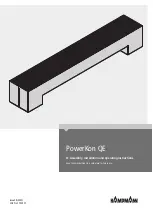
2
Another important consideration in selecting a location for the
unit(s) is the angle to obstructions. Either side adjacent the valves
can be placed toward the structure provided the side away from
the structure maintains minimum service clearance. Corner in-
stallations are strongly discouraged.
12"
12"
60"
24"
This unit can be located at ground floor level or on flat roofs. At
ground floor level, the unit must be on a solid, level foundation
that will not shift or settle. To reduce the possibility of sound
transmission, the foundation slab should not be in contact with
or be an integral part of the building foundation. The foundation
slab should be a minimum of 6” wider than the unit in all direc-
tions. Ensure the foundation is sufficient to support the unit. A
concrete slab raised above ground level provides a suitable base.
The selected site should be no greater than 50’ below or 70’ above
the evaporator section. For optimum performance, the minimum
length interconnecting tubing is preferred. When possible mini-
mize the amount of bends and turns.
Rooftop Installations
If it is necessary to install this unit on a roof structure, ensure the
roof structure can support the weight and that proper consider-
ation is given to the weather-tight integrity of the roof. Since the
unit can vibrate during operation, sound vibration transmission
should be considered when installing the unit. Vibration absorb-
ing pads or springs can be installed between the condensing unit
legs or frame and the roof mounting assembly to reduce noise
vibration.
Rigging
To avoid possible injury or death, all panels must be in position
and secured before lifting this equipment.
Use field-supplied spreader bars when lifting the unit to minimize
the possibility of lifting cable/straps damage. To protect the cabi-
net louvers, use protective material such as plywood behind the
cable/straps. Arrange the straps to form a central suspension
point. NOTE: When raising and setting the unit, observe all safety
rules. Remove shipping skid and all protection and lifting mate-
rial after the unit is in place.
Safe Refrigerant Handling
While these items will not cover every conceivable situation, they
should serve as a useful guide.


























